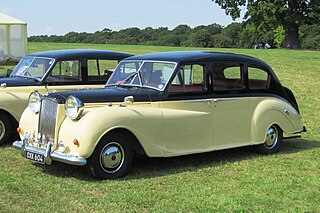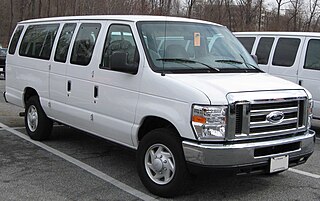
A hearse is a large vehicle, originally a horse carriage but later with the introduction of motor vehicles, a car, used to carry the body of a deceased person in a coffin at a funeral, wake, or memorial service. They range from deliberately anonymous vehicles to heavily decorated vehicles.

A van is a type of road vehicle used for transporting goods or people. Depending on the type of van, it can be bigger or smaller than a pickup truck and SUV, and bigger than a common car. There is some variation in the scope of the word across the different English-speaking countries. The smallest vans, microvans, are used for transporting either goods or people in tiny quantities. Mini MPVs, compact MPVs, and MPVs are all small vans usually used for transporting people in small quantities. Larger vans with passenger seats are used for institutional purposes, such as transporting students. Larger vans with only front seats are often used for business purposes, to carry goods and equipment. Specially equipped vans are used by television stations as mobile studios. Postal services and courier companies use large step vans to deliver packages.

The Austin Princess is a series of large luxury cars that were made by Austin and its subsidiary Vanden Plas from 1947 to 1968. The cars were also marketed under the Princess and Vanden Plas marque names.

The Lincoln Town Car is a model line of full-size luxury sedans that was marketed by the Lincoln division of the American automaker Ford Motor Company. Deriving its name from a limousine body style, Lincoln marketed the Town Car from 1981 to 2011, with the nameplate previously serving as the flagship trim of the Lincoln Continental. Produced across three generations for thirty model years, the Town Car was marketed directly against luxury sedans from Cadillac and Chrysler.

The Volkswagen Transporter (T4), marketed in North America as the Volkswagen EuroVan, is a van produced by the German manufacturer Volkswagen Commercial Vehicles between 1990 and 2004, succeeding the Volkswagen Type 2 (T3) and superseded by the Volkswagen Transporter (T5).

A flower car is a type of vehicle used in the funeral industry of the United States, frequently under the Cadillac brand. It is used to carry flowers for the burial service, or sometimes to carry the coffin under a bed of flowers. Built on the same commercial chassis as a hearse, the flower car has half-height rear bodywork on the rear similar to a pickup truck bed. The bed contains a liner to hold the flowers, normally built of stainless steel to resist rust. Some flower cars have a raised, flat tonneau cover across the bed at the top, upon which the flowers sit; the center portion sometimes is designed to raise and lower, hydraulically or by hand. If the flower car is designed to carry a casket, it will be stored under the tonneau cover in the space beneath, behind the opening rear gate.
There are many types of car body styles. They vary depending on intended use, market position, location, and the era they were made.

The first call vehicle is a vehicle used in the funeral service industry. This type of vehicle is used to pick up the remains of a recently deceased person, and transport that person to the funeral home for preparation. This initial pickup is called the "first call", hence the name of these vehicles. While some funeral homes will use their hearse for these initial pickups, having vehicles specifically for first calls and using the hearse solely for funerals reduces wear on hearses and makes the first call process more discreet. Sometimes, when the procession portion of funeral protocol comes into play, First Call vehicles double as funeral yield vehicles, which grants the procession the right of way.

The Ford E-Series is a range of full-size vans manufactured and marketed by the Ford Motor Company. Introduced for 1961 as the replacement of the Ford F-Series panel van, four generations of the model line have been produced. Marketed for both cargo and passenger transport configurations, the E-Series has been designed with multiple design variations for both retail and commercial sale, including vans, and commercial-grade cutaway van chassis and stripped chassis.

The Chevrolet Express is a series of full-size vans produced by General Motors since 1996. The successor to the Chevrolet G-series van, the Express is produced in passenger and cargo variants. Alongside the standard van body, the line is offered as a cutaway van chassis; the latter vehicle is a chassis cab variant developed for commercial-grade applications, including ambulances, buses, motorhomes, and small trucks.

The Cadillac Commercial Chassis is a chassis that was built by the Cadillac division of General Motors. Produced from 1931 to 1979, the Commercial Chassis was constructed as an incomplete vehicle intended for use by coachbuilders for final assembly and fitment of bodywork. Produced on the D platform throughout its entire production, the Commercial Chassis was initially derived from the Series 355, shifting to the Series 75 from 1936 onward.
The Wayne Corporation was an American manufacturer of buses and other vehicles under the "Wayne" marque. The corporate headquarters were in Richmond, Indiana, in Wayne County, Indiana. During the middle 20th century, Wayne served as a leading producer of school buses in North America.

The Ectomobile is a fictional vehicle from the Ghostbusters franchise. It appears in the films Ghostbusters (1984), Ghostbusters II (1989), the reboot, where in it appears as a hearse as opposed to the original's ambulance, Ghostbusters (2016), Ghostbusters: Afterlife (2021), in the animated television series: The Real Ghostbusters, Slimer! and Extreme Ghostbusters, and in the video games Ghostbusters: The Video Game and Beeline's Ghostbusters iOS app.
Superior Coach was a coachbuilder in the American automotive industry. Founded in 1909 as the Garford Motor Truck Company, Superior is best known for constructing bodies for professional cars (hearses) and school buses. Following major downturns in both segments in the late 1970s, Superior was liquidated by its parent company in 1980. From 1925 to 1980, the company was based in Lima, Ohio.

A combination car was a vehicle that could serve either as a hearse or as an ambulance, and had the capability of being swapped between those roles without much difficulty. This hybrid usage of the cars reflects an era when funeral homes offered emergency ambulance service in addition to their primary trade, especially in smaller towns and rural areas.

Cutaway van chassis are used by second stage manufacturers for a wide range of completed motor vehicles. Especially popular in the United States, they are usually based upon incomplete vans to be bigger or smaller than pickup trucks and SUVs made by manufacturers such as Chrysler, Ford, and General Motors which are generally equipped with heavier duty components than most of their complete products. To these incomplete vehicles, a second stage manufacturer adds specific equipment and completes the vehicle. Common applications of this type of vehicle design and manufacturing includes small trucks, school buses, recreational vehicles, minibuses, and ambulances. The term "cutaway" can be somewhat of a misnomer in most of the vehicle's context since it refers to truck bodies for heavy-duty commercial-grade applications sharing a common truck chassis.

The Cadillac V8, introduced as the Type 51, is a large, luxurious automobile that was introduced in September 1914 by Cadillac as a 1915 model. It was Cadillac's first V8 automobile, replacing the four-cylinder Model 30, and used the all new GM A platform for the entire series shared with all GM division brands using a 122 in (3,099 mm) wheelbase, while a 145 in (3,683 mm) chassis was offered separately to be used for custom coachwork. The Types 53, 55, 57, 59, and 61 were introduced every year through 1923 with yearly improvements until an all new platform was substantially updated and introduced as the V-63 using the business philosophy called planned obsolescence. It was built at the Cass Street and Amsterdam Avenue factory in Detroit, with the coachwork provided by Fisher Body. The chassis could be purchased separately and sent to the clients choice of coachbuilder optionally.

The Cadillac V-63 is a large luxury automobile that was introduced in September 1923 by Cadillac as a 1924 model, replacing the previous Type 61. It used the GM C platform and was replaced by the Cadillac Series 355 in 1931. It retained the name Cadillac V8 introduced with the previous generation Cadillac Type 51.

Soar Automotive (青岛索尔汽车集团) is a Chinese motor vehicle manufacturing company headquartered in Qingdao. It is specialized in coach building bespoke vehicles including ambulances, police cars, funeral hearses, limousines, courtesy buses and special military vehicles.















